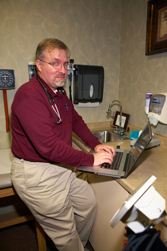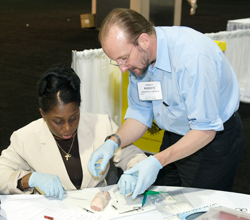Physicians and social media: Debating where to draw the line
Blogging doctors have a powerful megaphone and a new way to interact with their patients. But mishandling this tool, or misusing Twitter or Facebook, can blur the patient-physician divide or place the relationship at risk. Some of the internet's most famous physicians log in to discuss the pros and cons of social media.
Rob Lamberts, ACP Member, has blogged about the best ways to annoy your doctor, the insanity of hemorrhoid cream costing $100 and the difficulties involved in treating anxiety-prone patients. He's discussed some of the heart-rending complexities of caring for long-time patients who have lost their insurance coverage. And Dr. Lamberts' words aren't just vanishing into cyberspace. His blog, Musings of a Distractible Mind, gets about 20,000 visitors who view 50,000 pages a month, according to his own analytics data. His list of Twitter followers numbers more than 1,600 and counting.
The Georgia internist and pediatrician, whose blog incorporates haiku and other more comedic touches, admitted that initially he was “very conscious” that some of his patients were sifting through his posts. “Then I decided, you know what, that's kind of how I am with my patients anyway. I'm open with my patients. I want my patients to see me as a guy who just happens to be a doctor.”

Today's physicians have an ever-expanding number of social media vehicles through which to express themselves. Tools like Twitter, Facebook and blogging can potentially help physicians better educate and interact with patients, perhaps even humanizing themselves in the process. But mishandling that powerful online megaphone can potentially risk, or at the very least blur, the doctor-patient relationship, according to social media-savvy physicians.
Depending on what you share and how widely, your patients may know your marital status, your political views, where you went on your last vacation and your stress level on a given day. In short, social media allows patients to connect with you in ways that reverberate far beyond the exam room itself, said Lindsay Thompson, MD, MS, assistant professor of pediatrics at the University of Florida's College of Medicine in Gainesville. “I think it's an emerging and interesting field with some worry points,” she said.
Dr. Thompson helped author a study, published in 2008 in the Journal of General Internal Medicine, which found that nearly half of the medical students at University of Florida, Gainesville, had created Facebook accounts. Of those, only about one-third kept their accounts private. Some of the public pages included unprofessional material, such as foul or sexist language and, more commonly, pictures of drinking and partying. Another study, published in 2009 in the Journal of the American Medical Association, identified a similar pattern. Nearly two-thirds of 78 U.S. medical schools reported incidents of students posting unprofessional content online.
Heightened awareness can make a difference, Dr. Thompson said. She has since made an informal spot check and found that some of those public pages have been made private. Still, she's concerned.
“With the expanding use of Facebook over the past few years, it seems that people have more and more friends, up to thousands of friends on your Facebook page,” she said. “You can't have several thousand friends in real life. How is that possible virtually? So I would argue that's really only semi-private.”
Boundary issues?
Worrying about the doctor-patient boundary is nothing new, said Russ Cucina, MD, MS, a hospitalist and associate medical director of information technology at University of California, San Francisco. The difference is that a mishandled conversation with a patient who attends the same church likely will only be overheard by a few people, he said. “What's new is that if you screw this up on the Internet, you've screwed it up in a way that is by definition broadcast to the world and broadcast forever.”
Dr. Cucina, who recently taught a physician continuing education class called “Blogs, Tweets, Facebook and Mobile,” believes that a number of steps can help physicians career-proof their social media interactions. A good first move, he said: Create separate personal and professional Facebook pages to delineate a clear doctor-patient boundary.
Steer clear of any personal information on your professional Facebook page, he advised. Also, be very careful about what thoughts you spin off into cyberspace via Twitter. They can not only be “retweeted,” but also can be indexed and thus searchable at a later date, Dr. Cucina said. Before you tweet, consider whether you would want the same information broadcast in not only your local paper, but also a national paper, he said.
A random search by ACP Internist of physician-issued tweets in recent months identified primarily professional links to conference information, recent studies or health reform developments. But it also revealed some more personal comments. “For me the witching hour began yesterday when one of my patients went into v tach then v fib in front of my eyes,” posted one physician. Another quipped, “Just dropped my stinky white coat off at laundry services. Good luck, laundry lady, my coat stinks and is brown.”
When a physician sends a tweet, it's really unknown who out there is reading, including current or potential patients, said Daniel Z. Sands, FACP, director of medical informatics at Cisco Internet Business Solutions Group and a primary care physicians at Beth Israel Deaconess Medical Center in Boston. Given the space constraints of 140 characters, a physician also may inadvertently compress his or her comments in such a way that it fosters a misunderstanding, he said.
But Dr. Sands stressed that Twitter and blogging also can serve as powerful education tools to reach patients, a point echoed by other physicians. Enoch Choi, MD, a family medicine specialist in Palo Alto, Calif., has used Twitter and Web chats at MedHelp.org to address a lot of H1N1 influenza questions, including tweeting details about vaccine clinics. Sean Khozin, ACP Member, an internist in New York City, has used both his blog and Twitter to reference trends in health technology and policy, including topics that might be misrepresented in the media.
But he doesn't provide any details about his daily medical practice, he said.
“I never really talk about myself, so I don't reveal any personal information,” he said. “And I think for a physician that would be a little strange to do. Because the patient-doctor therapeutic relationship is very important, but it has to remain professional.”
Patient considerations
Some physicians have opted to blog and Twitter behind a cloak of anonymity, one that they strive to keep. A few, contacted to comment for this article, didn't respond. Dr. Lamberts has chosen a different route. On his blog, he simply uses “Dr. Rob.” But it only required a few minutes of computer sleuthing to locate his practice in Augusta, Ga.
Initially, when he was virtually unread, Dr. Lamberts said he blogged about a few interesting cases, always cloaking the patient details. But he soon halted that practice.
He will still mention patient situations in passing—it's difficult to talk about medicine without mentioning patients, he said. But he will alter key details, such as age or gender. In his post about uninsured patients, for example, he mentioned a patient with a catastrophic eye problem who didn't get the ophthalmologist follow-up needed to save their vision. The reference was fleeting; no gender was identified.
In a more recent post, titled “Deflating,” Dr. Lamberts wrote about the never-ending needs of his patients, a responsibility he carries with him on his days off. It was not designed to be a sob story, he said, but rather a window into the daily struggle of many physicians.
“I think it's good for my patients to be able to see that I do have emotions—that we are not automatons,” he said.
But physicians, in their desire to share, can sometimes place patient confidentiality at risk, said Dr. Thompson of the University of Florida. In her perusal of Facebook pages, she saw instances in which medical school students posted pictures of overseas medical mission trips, including of patients, she said.
What about friending patients on Facebook or other sites? Unlike some physicians interviewed, Dr. Sands has accepted some invites. “If you have a relatively clean social networking site, it's probably okay to have patients friend you,” he said. For his part, Dr. Lamberts has decided to draw his personal boundary a little differently by not accepting patient invites.
Regardless of how they are personally handling social media, the physicians interviewed did agree on one point. When handled well, social media can bolster the doctor-patient bond by providing a bridge that extends beyond the exam room door.
“Physicians are viewed as being inaccessible,” Dr. Khozin said. “If they put their face out there in the virtual domain, it shows that they're human. It shows their intellectual side. And patients respond very positively to that. And I think that's a good thing for our profession.”





